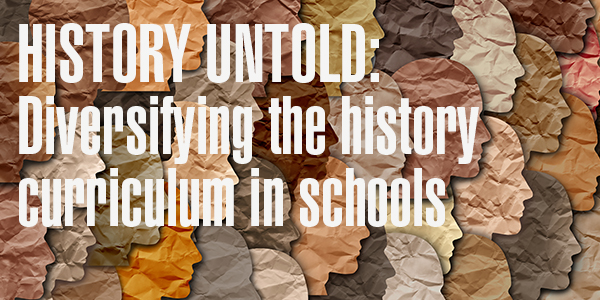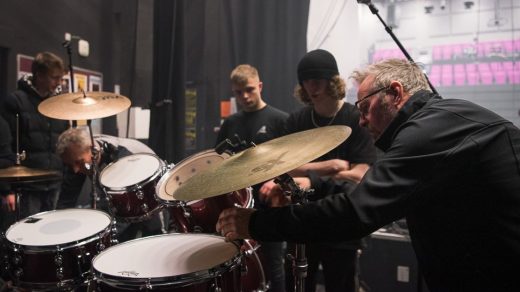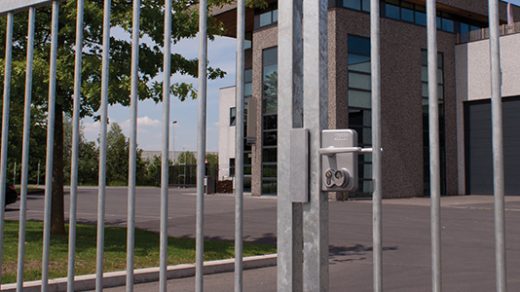History untold: Diversifying the history curriculum in schools

From September 2022, Wales will be the first UK nation to make teaching of black, Asian and minority ethnic histories mandatory in the school curriculum. With growing calls for England to follow its lead, Hannah Fowler explores the current history curriculum and the importance of representation in the classroom.
“If this is a great opportunity to learn and be engaged about our past, why are we not actually being taught about our past? …We need to open our minds, but how can we be taught to see if the blind leads the blind?”
These are a few poignant lines from Samuel King’s spoken word poem, ‘What I wasn’t taught in school’. The poem centres around the teaching of Black History Month and one student’s frustration that it isn’t taught with as much depth and with as much pride in schools.
This sentiment was recently echoed by footballer Troy Deeney, who launched an impassioned petition for more extensive teaching of black, Asian and minority ethnic experiences in England’s schools. In an open letter to education secretary Nadhim Zahawi, Deeney calls for England to make these teachings mandatory to “ensure that school children, from all backgrounds, have a balanced and inclusive understanding of Britian’s past, and how it has shaped society today.”
Back in 2011, then education secretary Michael Gove unveiled new plans for England’s history teaching, saying the new curriculum should “celebrate the distinguished role of these islands in the history of the world.” Gove removed the curriculum’s explicit focus on racial and ethnic diversity and made many black history topics optional. While the curriculum does suggest schools can teach topics such as “Indian independence and the end of Empire”, “the development of the British Empire” and the transatlantic slave trade, this freedom means many stories are going untold.
Deeney accompanied his petition with stats from a YouGov commissioned survey of British teachers. Only 12% of teachers surveyed feel “empowered” to teach ‘optional’ black-related topics such as colonialism, migration and identity against other competing ‘optional’ topics. 72% think the government should do more to support teachers in the teaching of cultural diversity in the curriculum, while 80% agree that introducing more culturally diverse, representational topics is vital and enriching for white or ethnic minority students.
“I think there is huge amount of scope within the current parameter of the national curriculum,” says Katie Amery, Head of History and Politics at West Kirkby Grammar School in Wirral.
“However, staff need to be well read, informed and keen to integrate in black, Asian and minority ethnic threads throughout Key Stage 3.”
Katie has 15 years’ experience as head of department and is passionate about improving diversity in the history curriculum. Katie heads up a local network of history teachers, mentors newly qualified teachers and is currently curating a textbook in collaboration with other history leads, the ISM and History England about Liverpool’s role in the transatlantic slave trade.
Now, more than ever, students are no longer passive consumers of their own education. Movements such as Black Lives Matter, protests in the wake of Sarah Everard’s death, the Windrush scandal and the current situation in Ukraine have incentivised people to take action. No more so than young people who are finding their voices, harnessing social media and leading the fight for change in their own communities.
“My curriculum has evolved significantly in light of the murder of George Floyd and the pulling down of Colston’s statue,” says Katie. “Like many history departments I received a petition signed by hundreds of former students demanding greater representation of black, Asian and minority ethnic narratives in our programmes of study.”
“Initially I was deeply upset and felt like our coverage of the Slave Trade and American Civil Rights was more than sufficient. On reflection, I realised our provision was poor and history departments have a huge responsibility to address the idea of the construct of race and the contributions made by non-white British people, to in some way understand the current issues surrounding race in the UK.”
Katie says she immersed herself in books by David Olusoga, Miranda Kauffmann, Toby Green and Peter Frankopan to understand how to incorporate black history in to the curriculum and “how best to sequence and weave in black, Asian and minority ethnic history and how to do it with sensitivity and meaning.”
In Year 7, students now learn about medieval Baghdad through a global study, medieval monarchs such as Mansa Musa of the Mali Empire and explore the life of black Tudors during the Tudor and Stuart eras. Figures such as John Blanke, Diego and Mary Fillis are profiled and discussed.
In Year 8, students look at the history of Benin and the looting of the Oba’s Palace in 1897 by British Colonial troops. Katie incorporates a local lens to as many of these topics as possible, visiting artefacts and artwork at World Museum in Liverpool and the Lady Lever Art Gallery respectively.
“We worked alongside members of the L8 community to consider ways in which artefacts could be displayed to reflect the skill through which they were made and the way in which they came to be in the museum,” explains Katie. This then opened up a larger debate around museum collections and colonial injustice, with some students writing to the curator as they felt the objects should be returned to West Africa.
When discussing the transatlantic slave trade, Katie says careful focus is given to language. “We use the term ‘enslaved’ rather than ‘slave’ and focus very much on resistance (Nanny, Sally Bassett) and the role of Africans on plantations and their contributions to abolition, rather than the role of wealthy, white MPs,” she adds.
We don’t have to look very far to see that change can happen. In neighbouring Wales, the learning of black, Asian and minority ethnic histories and experiences will be mandatory from September 2022. The new curriculum will include six areas of learning and experience: expressive arts; health and wellbeing; humanities; languages, literacy and communication; mathematics and numeracy, and science and technology.
Each area includes mandatory elements named ‘statements of what matters’, and under humanities it reads “… learners can develop an understanding of the complex, pluralistic and diverse nature of societies, past and present. These stories are diverse, spanning different communities as well as in particular the stories of black, Asian and minority ethnic people.”
The delivery and implementation of the new curriculum is supported by an investment of £500,000, which will be used to improve educational resources, workforce training, professional development and Initial Teacher Education.
Katie says that there are challenges to introducing more diverse histories successfully, many of which revolve around time, cost, the willingness of staff to create new resources and sourcing contributions from non-white educators and communities. She also recognises that the history content at GCSE and A-level are narrow in scope and lack diversity.
Echoing the opening quote from King’s poem, how can we be taught to see if the blind leads the blind?
Headteacher Roanne Clements-Bedson from Knotty Ash Primary School, wanted to introduce a more diverse curriculum to make subject content meaningful and relevant to children’s experience and awareness of local, national and global issues. So, they started from scratch.
“We started from a blank piece of paper and built up the curriculum we believed in: one that would equip our children with the knowledge they need to understand the complexities of today’s world,” explains Roanne. “We started by identifying the key issues to be understood in order to give a context for current events and future developments.”
Key issues identified include human rights, difference and diversity, peace and conflict, social justice, self-identity and environment and sustainability.
The Liverpool school then layered the national curriculum onto the themes. For example, when approaching the statutory topics ‘a non-European society – Benin (West Africa) c. AD 900-1300’, the school uses this as a starting point to weave in other histories.
“[It then moves on to] the transatlantic slave trade and Liverpool’s role in it, the abolition in the UK and US, then moves on to finding out about segregation and the American Civil Rights Movement. It ends by exploring issues of racism today, including the killing of George Floyd, reaction and change,” says Roanne.
“By focusing on our curriculum’s underpinning themes, we have been able to create a history curriculum that is far richer than a series of isolated topics.”
But similarly to Katie, Roanne recognises that there are challenges to introduce black, Asian and minority ethnic history successfully, particularly within the current parameters of the national primary school curriculum.
“The primary emphasis on ancient civilisations limits the scope for diversifying the history curriculum,” explains Roanne. “Our children risk developing stereotypes about modern societies (in China, Egypt, Northern India and Iraq) based on a knowledge of their ancient counterparts.
For this reason, it’s important that the geography and history curricula work together to provide modern context.” But there are signs that the curriculum is adapting to reflect modern histories and events, albeit regionally. It was recently announced that all primary and secondary schools in the Liverpool City Region will hold a ‘Hillsborough Day’ every year in April. Students will take part in a special assembly to mark the anniversary, as well as learning more about the disaster and the fight for justice. Everton ward councillor Ian Byrne, who proposed the motion, hopes it will be rolled out across the country as part of the national curriculum.
Roanne thinks it’s important to adapt curriculum content to a school’s context. “For instance, thinking about our study of the history of racism: in a Liverpool school, the city’s role in the transatlantic slave trade needs to be explored, whereas where I grew up in Leicestershire, the topic may be more relevantly focused on the British Raj, the partition of India and postwar migration to work in the UK,” she explains.
In 2020, research found that almost half of schools in England have no black or minority ethnic teachers. As a result, many minority ethnic students are going through school without seeing their background represented through those teaching them. Diversity matters, especially if we want a curriculum which encourages openness, and fosters better understanding and tolerance among children.
Roanne is honest about this aspect of “authenticity” when teaching history. “We’re predominantly white British staff and as much as we try to inform ourselves, we don’t have lived experience of some of the issues we’re trying to educate our children about,” she says. “While we can invite visitors and organise visits to provide authentic voices in the delivery of the curriculum, in terms of having that input into curriculum design, this is a challenge we haven’t yet overcome.”
At the time of print, Deeney’s petition has reached over 58,000 signatures and has gathered hundreds of comments and shares in support. Despite the government insisting that the national curriculum is already diverse, people power is in full force and as we’ve seen before, small movements can grow.
In the words of Dr Martin Luther King Jr, “The time is always right to do what is right.”
By Hannah Fowler









